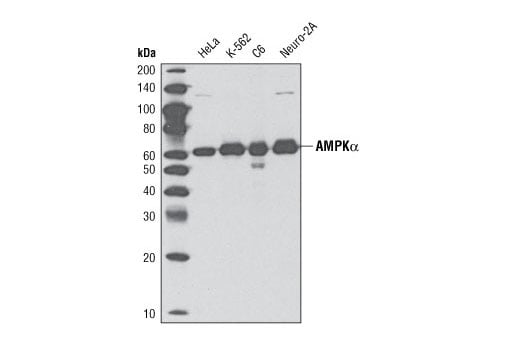 全部商品分类
全部商品分类
产品介绍
产品介绍
产品信息
荧光素标记
抗原名称
AMPKalpha

来源纯化
Monoclonal antibody is produced by immunizing animals with a synthetic peptide corresponding to residues surrounding Lys40 of human AMPKα.

宿主
Rabbit

商品描述
Product Usage Information
| Application | Dilution |
|---|---|
| Western Blotting | 1:1000 |
| Immunoprecipitation | 1:50 |

同种型
Rabbit IgG

分子量
62

研究领域
癌症,细胞生物学,纤维化,代谢,神经科学

应用
反应种属
Human,Mouse,Rat,Monkey,Bovine,

目标/特异性
Specificity/Sensitivity
AMPKα (D63G4) Rabbit mAb detects endogenous levels of total AMPKα1 protein. The antibody does not cross-react with AMPKα2.
Species Reactivity:
Human, Mouse, Rat, Hamster, Monkey, Bovine

敏感性
Endogenous

背景
背景
AMP-activated protein kinase (AMPK) is highly conserved from yeast to plants and animals and plays a key role in the regulation of energy homeostasis (1). AMPK is a heterotrimeric complex composed of a catalytic α subunit and regulatory β and γ subunits, each of which is encoded by two or three distinct genes (α1, 2; β1, 2; γ1, 2, 3) (2). The kinase is activated by an elevated AMP/ATP ratio due to cellular and environmental stress, such as heat shock, hypoxia, and ischemia (1). The tumor suppressor LKB1, in association with accessory proteins STRAD and MO25, phosphorylates AMPKα at Thr172 in the activation loop, and this phosphorylation is required for AMPK activation (3-5). AMPKα is also phosphorylated at Thr258 and Ser485 (for α1; Ser491 for α2). The upstream kinase and the biological significance of these phosphorylation events have yet to be elucidated (6). The β1 subunit is post-translationally modified by myristoylation and multi-site phosphorylation including Ser24/25, Ser96, Ser101, Ser108, and Ser182 (6,7). Phosphorylation at Ser108 of the β1 subunit seems to be required for AMPK activation, while phosphorylation at Ser24/25 and Ser182 affects AMPK localization (7). Several mutations in AMPKγ subunits have been identified, most of which are located in the putative AMP/ATP binding sites (CBS or Bateman domains). Mutations at these sites lead to reduction of AMPK activity and cause glycogen accumulation in heart or skeletal muscle (1,2). Accumulating evidence indicates that AMPK not only regulates the metabolism of fatty acids and glycogen, but also modulates protein synthesis and cell growth through EF2 and TSC2/mTOR pathways, as well as blood flow via eNOS/nNOS (1).
1.Hardie, D.G. (2004) J Cell Sci 117, 5479-87.
2.Carling, D. (2004) Trends Biochem Sci 29, 18-24.
3.Hawley, S.A. et al. (1996) J Biol Chem 271, 27879-87.
4.Lizcano, J.M. et al. (2004) EMBO J 23, 833-43.
5.Shaw, R.J. et al. (2004) Proc Natl Acad Sci USA 101, 3329-35.
6.Woods, A. et al. (2003) J Biol Chem 278, 28434-42.
7.Warden, S.M. et al. (2001) Biochem J 354, 275-83.

研究领域
癌症,细胞生物学,纤维化,代谢,神经科学
翻译后修饰
unmodified

制备和贮存
保存方式
Supplied in 10 mM sodium HEPES (pH 7.5), 150 mM NaCl, 100 µg/mL BSA, 50% glycerol, and less than 0.02% sodium azide. Store at –20°C. Do not aliquot the antibody.
For a carrier free (BSA and azide free) version of this product see product #97117.
数据库链接
Entrez-Gene ID
5562,5563

UniProt ID
Q13131,P54646

参考图片
Western blot analysis of extracts from HeLa, K-562, C6, and Neuro-2a cells using AMPKα (D63G4) Rabbit mAb.
声明 :本官网所有报价均为常温或者蓝冰运输价格,如有产品需要干冰运输,需另外加收干冰运输费。








 用小程序,查商品更便捷
用小程序,查商品更便捷




